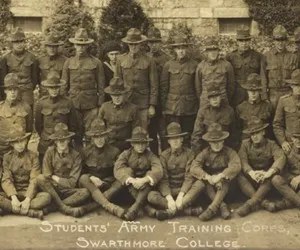1918 Student Army Training Corps

Several members of the faculty were prominent in the peace movement during the early years of World War I. Among them was historian William I. Hull, who served as a trustee of the New Peace Union and as a delegate to the International Conference of Education at the Hague. In 1917, Jesse Holmes, a popular philosophy professor, helped found the American Friends Service Committee, which provided young Quakers and other conscientious objectors an opportunity to perform community service instead of fighting. But once the United States entered the war, the mood on campus quickly shifted away from the strong influence of Quaker pacifism.
While some maintained their pacifist convictions and others supported humanitarian and non-military service in the war, students largely became enthusiastic followers of President Woodrow Wilson. Some professors left immediately for the armed services, and several students joined them or began war work as civilians.
In spring 1918, the Men's Student Government presented the Board with a petition, signed by many faculty members and almost every male student, requesting a compulsory military program. By May, the Board resolved to make military training available for those who wanted it.
President Joseph Swain soon became concerned about a serious drop-off in the male undergraduate population. After Congress lowered the draft age to 18 that summer, Swain declared that if Swarthmore did not accept a Student Army Training Corps, the College would be completely disrupted. The College accepted such a unit, the only Quaker college to do so. The Friends Intelligencer decried the decision, saying the College had "compromised with evil" and had been "put to the test and found wanting."



